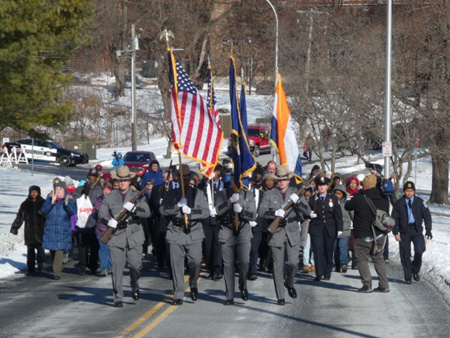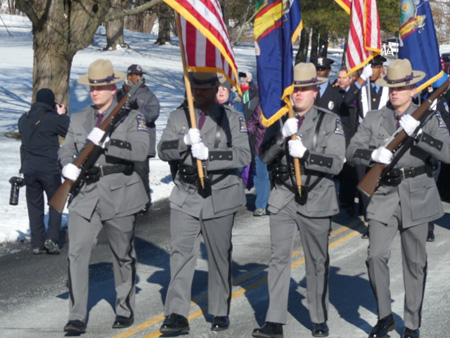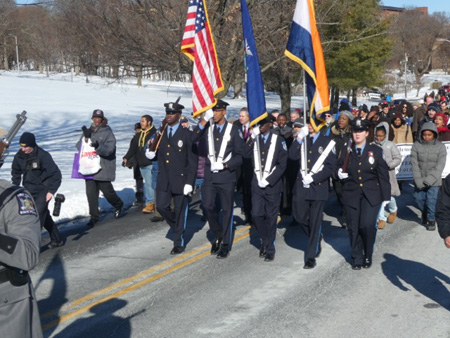October 13, 2019
Citizen’s groups form for and against the construction of large apartment buildings
I was hoping for some shouting and threats, maybe even some thrown chairs and a fistfight. But no, I was severely disappointed, everybody eased into the subject that evening at the main library and found out they had more common ground than conflict. Sure, the discussion was constructive and eased a lot of tensions that had been growing throughout this past year, but for sheer entertainment nothing beats a small riot and a trashed public meeting room.
The subject at hand was far from trivial, the siting of new apartment buildings is a vital turning point in the effort to rebuild the City of Albany and reverse the 70 year decline in our population. On the one hand there are those who are enthusiastically in favor of providing new living space inside the City so that people will live here and pay taxes and support businesses and not clog up our streets by commuting back and forth from the suburbs. Then there are others who see the surge in construction as a grave imposition on their homes, “changing the character of our neighborhoods” by siting large residential structures in areas where small residential buildings predominate.
Everyone agreed, or at least conceded, that providing new living space for people who want to move into the City of Albany is necessary and important for the economic health of our community. There is indeed a housing shortage in Albany, as a landlord I know that quite well. The main point of contention turns out to be over what kind of construction is appropriate and where precisely it’s located. What we learned that evening is that it seems we have little choice with the sort of buildings that developers want to build, we either let those large apartment blocks get built or settle for nothing.
 Everyone Got Along Fine At The Library Meeting, No Assaults Or Death Threats
Everyone Got Along Fine At The Library Meeting, No Assaults Or Death Threats
This was at a panel discussion held at the monthly Council of Albany Neighborhood Associations (CANA) meeting at the beginning of October. It was well attended, I estimated about 40 people showed up, many of whom I’d never seen at CANA before, along with a content provider from the Hearst Times Union. This is good, attendance at CANA meetings has been falling off lately. Us hardcore regulars have been showing up regularly, but for a while it had gotten so dismal that at the beginning of this year Mayor Kathy Sheehan declined to attend and speak to us because the group had become so small, breaking a tradition of mayors meeting with us annually going back about 30 years.
We couldn’t blame her for that. The problem is that unlike her predecessors, Ms. Sheehan regularly makes herself available to meet the citizens in various forums across the City on a regular basis. We even had a discussion at a recent CANA meeting about this, that the damn City officials had become so responsive lately that the public no longer goes out of their way to see and talk to their leaders at CANA when they get the chance. It’s like the novelty of being face to face with the mayor has worn off.
But as any neighborhood activist can tell you, it takes a neighborhood controversy to get the neighbors to attend neighborhood meetings. Much of the controversy around these new apartment buildings is centered around the mayor and her decision to allow and support the prevailing construction methods currently favored by developers. Should the mayor have allowed, some say forced through, the construction of these large “stick construction” apartment blocks that are being proposed? Or should she have held out for smaller buildings considered closer to traditional Albany small architecture, and risk getting nothing new built?
 Vince Raguso In Front Of Albany City Hall
Vince Raguso In Front Of Albany City Hall
We had six panelists that evening. However, it is important to mention that perhaps the number one agitator behind this controversy was not sitting on the panel, he sat right in front of the panelists. Vincent Raguso is one of those aforementioned hardcore regular CANA attendees, he is also the president of the Eagle Hill Neighborhood Association, an area located around upper Western Avenue approaching the City border with the suburb of Guilderland. He is also sometimes called “the 16th Common Council member” because he attends almost every Common Council meeting and almost always gives the elected officials an earful of his opinion.
Vince has started a Citywide group based mostly in the uptown neighborhoods called Stop The Stories, which at first might sound like they want to quash rumors but is actually in reference to the size of these apartment housing proposals, that in many locations rise to six or seven stories high. This is mainly what he and his neighbors object to, they are resisting what they see as the imposition of large apartment blocks near uptown residential areas composed of mostly single family houses.
After deciding that the mayor and the City departments were not even paying attention to their concerns, Vince and the Stop The Stories group decided to promote a radical solution that was guaranteed to get attention. They are calling for a moratorium on all development in the City of Albany. The idea is to use the moratorium period to revise zoning and planning initiatives to suit the needs of neighborhoods that feel they’ve been left out of the process.
City officials, of course, have responded with annoyed disdain at this proposal. Their position is that they have been soliciting public input over the revision of the zoning laws for several years now, why didn’t these folks participate in the process when it was open? The response from the group has been that they did indeed participate, especially Vince. But they say their concerns were mostly dismissed, and in addition they were given promises that have not been kept, particularly about continued citizen input.
 City Of Albany Commissioner Of Planning Chris Spencer
City Of Albany Commissioner Of Planning Chris Spencer
From 1950 up until this decade, the population of Albany has steadily declined, especially after the ridiculous anti-urban zoning code adopted in 1968. In 2012 Kathy Sheehan and her allies were swept into office partly on a promise of promoting policies that encourage the expansion of available housing, which at the bottom meant radically revising the zoning laws. And she has kept that promise, bringing in competent expertise in the form of the commissioner of planning Chris Spencer, who wrapped up the long, hard revision of the zoning laws that was finalized and passed at the end of last year.
Besides exacerbating population decline, that terrible 1968 zoning code led to a big increase in land use which in turn has steadily reduced tax revenue to the City, forcing property taxes higher. Fifty years ago this made perfect sense to the Apostles of Sprawl that dominated our community and the entire nation, those people seriously believed that Cities were old fashioned and needed to be replaced with wasteful and inefficient suburban sprawl. For most of us Albany citizens in the 21st Century, who are now dodging suburban traffic in front of our homes and paying higher taxes, that attitude is absurd.
What has changed since 1968? Part of it is that suburbs are becoming too expensive to maintain, but also there has been a massive generational shift in attitudes about the desirability of City living. My parent’s generation and my own Baby Boomer generation mostly favored that bizarre anti-urbanism. Today a large number of younger than 50 don’t want to isolate themselves in suburban residences and depend completely upon automobiles that they have to maintain, they are not attracted to that bizarre kind of life. They want to live in communities that are walkable and thus more affordable. This is especially true of Millennials, who right now are the backbone of society, the ones who are doing most of the actual work that sustains their declining elders.
Meanwhile, quite a few suburban municipalities are rethinking what they have done to themselves. Suburban elected officials frequently chatter about “New Urbanism” and propose the construction of “town centers.” It seems that quite a few people who reside in the suburbs are desirous of urban amenities. As Martin Daley, one of the panelists at that CANA meeting put it (in answer to a snarky comment from someone in the audience), “Here in Albany we don’t need New Urbanism, we already HAVE Urbanism.”
 Stop The Stories Protest In Front Of City Hall Last June
Stop The Stories Protest In Front Of City Hall Last June
Back in the beginning of June, the Stop The Stories group held a big protest in front of Albany City Hall on a Monday, the day the Common Council meets. At its peak I counted about 80 people on the sidewalk holding signs, chanting and greeting the Common Council members as they arrived, some of whom briefly joined the protest before going inside. (The Hearst Times Union as usual lied and said “almost 40.”) They were orderly but some of them were quite rude and nasty. When I went over there to take photos, one woman started harassing me, ordering me to turn around so she could take my picture. I showed her my back and with great difficulty refrained from showing her my middle finger (“picture this.”)
Across Eagle Street in Academy Park there was a counter protest hastily organized by Andrew Neidhardt. He’s started a group called Walkable Albany, which describes itself as “A group of citizens advocating for Albany’s historic, beautiful, vibrant, dense, and walkable neighborhoods.” This protest of the protest across the street had half the size, no more than forty people (again, the Hearst Rag claimed “about 25.”) I was with this group (which explains why I was threatened when I crossed the street) and we too had signs and speeches, but we weren’t big on chants.
It could be readily seen that the Stop The Stories people in front of City Hall were older people, most were over 50 and I doubt there were any among them under 40. As best as I could tell they were all from uptown neighborhoods, I didn’t see anyone I recognized that I knew to live downtown or near. And as far as I saw every last one of them were white.
 Counter Protest Across The Street, Andrew Neidhardt Of Walkable Albany Declaims On A Milk Crate
Counter Protest Across The Street, Andrew Neidhardt Of Walkable Albany Declaims On A Milk Crate
Our smaller group was a whole lot younger and included several parents pushing strollers, The Wife and I were probably the oldest attending. And this group included a few people of color. Standing on an honest to goodness milk crate, Mr. Neidhardt put forth the theme that density is desirable in an urban community, and if we don’t plan for density then we are planning for decline as a community. This was a direct reaction to the loud demand from across the street for a moratorium on development, which at that point seemed to those of us in Academy Park to be the sum total of the Stop The Stories program.
Except for myself and a Hearst content provider, no one wanted to cross the street and risk a confrontation with the other group. Too bad, a riot around the Phillip Schuyler statue would have been entertaining, even though our side was outnumbered. And as an aside, I don’t recall if any cops showed up. This is Albany after all, we have demonstrations and protests and street marches somewhere in the City several times a week when the weather is tolerable and often enough when it’s not. The Albany Police learned a long time ago to relax and direct traffic and let the activities happen.
 Panel Moderator Robert Murphy
Panel Moderator Robert Murphy
The CANA panel was put together by Robert Murphy, president of the Whitehall Neighborhood Association, he acted as moderator. And he did a good job, he proved himself personable and fair to everybody and is perhaps the main reason why this meeting did not devolve into a series of shouting matches and slap fights. This was particularly impressive considering that there were several hotheaded people on the panel and more than several in the audience.
The representative of Stop The Stories was Zachary Simpson, he lives in the Melrose neighborhood and is a fellow board member of CANA. Zach made it clear that Stop The Stories is about a lot more than just demanding a moratorium on development, the group wants more mixed use in the proposals and, of course, smaller buildings, fewer stories. The thinking is that these large developments actually destroy the walkability of neighborhoods with their presence, and the sudden introduction of population density that come with these buildings increases auto traffic.
 Zach Simpson Of Stop The Stories
Zach Simpson Of Stop The Stories
This last point about traffic. Stop The Stories complains that the uptown neighborhoods are inundated every weekday morning with suburban autos driven by suburbanites passing through their neighborhoods to their jobs downtown, and then again in late afternoon. In principle, it makes more sense to offer as many of these suburbanites with housing inside the City, not only to pay taxes but to clog up our roads a lot less.
The counter argument to that is while building a large, densely occupied building in your own neighborhood may reduce overall traffic a bit, it is very likely to increase traffic locally around your own house. Is that true? During morning and evening rush hours, the main avenue through my own neighborhood, which is located on one side of downtown, is also bumper to bumper almost exclusively with suburbanite commuters.
From years of observation I’ve seen that people who live in my neighborhood tend to drive their cars as little as they can. Most would rather walk, take the bus, or bike as often as possible. And a lot of my neighbors don’t even bother with the expense and trouble of owning a car.
 The Almost Unnoticeable Seven Story Extended Stay Hotel In My Neighborhood
The Almost Unnoticeable Seven Story Extended Stay Hotel In My Neighborhood
A couple of blocks from my house is an 8 story building that used to be a nursing home, but went out of business leaving the building vacant for years. At the end of the last decade a developer turned what had become a decrepit hulk into an extended stay hotel, and this new business has had zero effect on local traffic. Not even noticeable. Meanwhile the suburbanite autos continue to clog up the roads in front of that building twice a day.
As an ally on the panel to Stop The Stories, Sue Cotner, executive director of Affordable Housing Partnership, maintained that the best solution to the housing crisis is to rebuild the already available vacant housing, more than a thousand residential buildings scattered across the City. I know well how over the years Sue has worked to prevent random demolitions, to bring vacant houses back on line, and to keep occupied but disintegrating homes from going vacant. I was delighted to hear that her organization is in the process of purchasing some 30 vacant houses from the Albany County Land Bank, which they plan to rehab and then match with persons of modest means who wish to own their own homes.
 Sue Cotner Of Albany Housing Partnership
Sue Cotner Of Albany Housing Partnership
This is excellent work and I wish there were several dozen agencies with directors like Ms. Cotner out there doing the same thing, our vacant building problem would disappear. But while it is vital to preserve and renovate the housing that we already have, that does not go far enough to provide enough housing and to significantly increase the population of our community. We should not be destroying or allowing to go to ruin existing housing, but at the same time we need more housing units on top of those. And new housing units mean greater density.
Andrew Neidhardt was on the panel, he dismissed the oft-cited concerns about parking and traffic. “People want to live where parking is hard,” he told us. Younger, higher income people gravitate toward what he calls “neighborhood centers,” places where it is easier to get around by foot than by auto. And yeah, we see this in big Cities where the very wealthy have taken possession of the hearts of downtown for themselves, relegating us lower income people to the suburbs or to smaller Cities like Albany. The rich always buy up what is most desirable, and many of them recognize the value of urban centers.
 Andrew Neidhardt Of Walkable Albany
Andrew Neidhardt Of Walkable Albany
An astonishing comment from Mr. Neidhardt was about the Home Depot in Albany (not sure if he was referring to the one along the Central Avenue auto slum or the one on Washington Avenue Extension that destroyed 25 acres of prime Pine Bush.) “That Home Depot pays some $11 million in property taxes annually. But if you put ten blocks of houses on that spot the City would receive ten times more in taxes.” Is that an exaggeration? I’d like to see a solid breakdown of figures to confirm that.
A woman named Pam Howard occupied a seat on the panel. She’s the current director of Historic Albany Foundation (HAF), a self-perpetuating non-profit that under her longtime predecessor Susie Holland operated as an ally to former mayor Jerry Jennings, routinely rubberstamping midnight building demolitions and doing little more than providing a good income for Susie until Jerry left office and she had to leave town. That, of course, is my opinion. Ms. Howard admitted that she doesn’t live in the City of Albany, she’s a suburbanite from Saratoga County. She might as well have sent a potted plant to sit in her chair instead, she had nothing to add to the discussion.
 Martin Daley Of The Capital District Regional Planning Commission
Martin Daley Of The Capital District Regional Planning Commission
The sixth panelist was Martin Daley of the Capital District Regional Planning Commission, a lifelong City of Albany resident and a passionate urbanist. Currently he lives uptown in Pine Hills, but is strongly opposed to the aims of Stop The Stories. From the start of the discussion he dominated the panel with his expertise in planning matters, which includes his current position as project manager for the decidedly unglamorous but vital Long Term Control Plan, the State sponsored effort to deal with the combined sewer overflow (CSO) crisis in Albany and regionally.
One of the issues brought up repeatedly by Stop The Stories is stormwater runoff from these new apartment block proposals, the possibility that they will make much worse the sewer and storm drain backflow problems that have repeatedly resulted in flash floods and drowned basements. Mr. Daley pointed out what most people don’t know, that since 1983 Albany has had “some of the most restrictive and innovative stormwater runoff regulations in NY State.” Since that date, all new construction above a certain size has to provide catch basins or some other method to channel sudden surges of water, and this is enforced by issuance of a CSO permit to each project. Thus it is unlikely these new projects will contribute to further flooding issues, if anything they will help solve the running problems with the old CSO infrastructure by providing more catch basins.
Mr. Daley answered a question of mine, why do we have these “stick construction” apartment blocks being proposed almost exclusively not only in Albany but also in the suburbs and all across the State? Sure, single family house construction has fallen off drastically and demand for rental apartments has surged, but why these behemoths and not smaller buildings? Is it merely because developers find them more profitable?
 Five Story Apartment Block Planned For 563 New Scotland Avenue
Five Story Apartment Block Planned For 563 New Scotland Avenue
To put it another way, do these big stick construction projects have to have a big footprint and rise to six or seven stories, or is this just developers trying to squeeze in extra profit? The answer is that profitability is of course an essential driving factor. I know well that without government subsidies, smaller buildings have consistently proven unprofitable for developers, and renovations of older building have also proven to be massively unprofitable. Those subsidies for renovation, which peaked in the 1970s and resulted in such spectacular successes as the total rebuilding of the Center Square and Hudson Park neighborhoods around upper Lark Street, have mostly dried up.
According to Mr. Daley, what makes these new stick construction buildings profitable is that by law any of them larger than two stories has to have a series of features including an elevator, and must use materials that will discourage fire from spreading. The cost of the necessary materials drives up the overall cost considerably. Thus the extra stories ARE the profit, which in the absence of subsidies, makes the projects worthwhile to the developers.
This limits the range of options open to Albany at this particular time, that is, if we want new residential construction. Our City is not alone with this limitation, the majority of new proposals in nearby suburbs such as Guilderland and Bethlehem are almost exclusively the same large block stick construction, and they are building a lot of them. Until and if subsidies for building and renovation become available again, or if there are major changes in building materials and costs, or if State standards of allowable construction shift drastically, we can expect that these will be the prevailing proposals for the foreseeable future.
 Drawing Of The Proposed Apartment Building At 1211 Western Avenue
Drawing Of The Proposed Apartment Building At 1211 Western Avenue
These new buildings will increase population density inside Albany without extending expensive infrastructure to accommodate the developers. In the last century the City administrations enthusiastically encouraged sprawl development of undeveloped Pine Bush in the western end of the City, providing new infrastructure to the developers at taxpayer expense. These policies were enshrined in the bad old zoning code of 1968, this is precisely why our population has declined and our property taxes have skyrocketed, and why so many of our neglected neighborhoods disintegrated.
It would be unfair to say that all the organizers and supporters of Stop The Stories think the same and have the same goals. But I think it telling that over the years, main organizer Vincent Raguso has always very vocally supported sprawl development in the Pine Bush, coming out to speak in favor of every single proposal at Common Council and planning board meetings. In sharp contrast he has vigorously opposed, in particular, one of these proposals along the well-populated corridor at 1211 Western Avenue, which is close to his own neighborhood.
I guess you could say that Vince is old school when it comes to development options. It has always been strange and baffling to me that anyone would favor sprawl in the first place, so I’m not one to judge him. Not all that long ago Vince’s point of view on these matters was the majority opinion, near unanimous among those in charge. And it seems like only yesterday that my own pro-urban anti-sprawl attitude was considered bizarre, routinely sneered at by those who claimed to “know better.”
 Construction At 363 Ontario Street
Construction At 363 Ontario Street
The location of these apartment buildings has been an issue. With one major exception, all the proposals, such as 1211 Western Avenue and 563 New Scotland Avenue have been located on main corridors, what Mr. Neidhardt referred to as “neighborhood centers.” These are the appropriate places to build apartment blocks in an urban community.
The one exception has been the three apartment buildings under construction at 363 Ontario Street, not even remotely a main avenue. The site was an old bowling alley, but there are also a lot of single family houses right next to the site. And yet, across the street a little ways downhill from the site is a big block of apartments already in place called Park Row. I don’t see that the “character of the neighborhood" is being changed all that much, it actually seems to make it more substantial. Perhaps the neighbors who objected to it simply don’t like change.
 Sprawl Suburb Clifton Park Is Attempting To Construct A Walkable “Town Center”, Photo From Last Year
Sprawl Suburb Clifton Park Is Attempting To Construct A Walkable “Town Center”, Photo From Last Year
A final issue that gets tossed about is whether or not these newly constructed apartments, despite the acute apartment shortage, will get occupied. Most new units in these proposed buildings are considered high end, will people in Albany want to pay those prices? I’ve heard about a growing number of vacancies among these already constructed new buildings, but these are anecdotes that I haven’t seen confirmed. So far there hasn’t been any surveys of occupation that I’ve seen.
What I hear repeated over and over from young middle class people who are trying to get ahead is that the the current apartment situation in Albany is not acceptable to them. They want to, or they aspire to, live in high end housing. They repeatedly say they will be forced to leave town if the housing situation doesn’t change, the available housing they want mostly does not much exist yet. Albany cannot afford to continue to lose the middle class. If building these proposals stops the ongoing exodus then these proposals are desirable and necessary.
 The March Through Lincoln Park
The March Through Lincoln Park  Ornamental Apple Tree In Lincoln Park
Ornamental Apple Tree In Lincoln Park  Springtime Apple Blossoms On Morton Avenue Last April
Springtime Apple Blossoms On Morton Avenue Last April  The Wreath Ready To Be Presented To Dr. King
The Wreath Ready To Be Presented To Dr. King  Cold Cops On Horses
Cold Cops On Horses  State Troopers
State Troopers  Albany Police Explorers
Albany Police Explorers 
 Everyone Got Along Fine At The Library Meeting, No Assaults Or Death Threats
Everyone Got Along Fine At The Library Meeting, No Assaults Or Death Threats  Vince Raguso In Front Of Albany City Hall
Vince Raguso In Front Of Albany City Hall  City Of Albany Commissioner Of Planning Chris Spencer
City Of Albany Commissioner Of Planning Chris Spencer  Stop The Stories Protest In Front Of City Hall Last June
Stop The Stories Protest In Front Of City Hall Last June  Counter Protest Across The Street, Andrew Neidhardt Of Walkable Albany Declaims On A Milk Crate
Counter Protest Across The Street, Andrew Neidhardt Of Walkable Albany Declaims On A Milk Crate  Panel Moderator Robert Murphy
Panel Moderator Robert Murphy  Zach Simpson Of Stop The Stories
Zach Simpson Of Stop The Stories  The Almost Unnoticeable Seven Story Extended Stay Hotel In My Neighborhood
The Almost Unnoticeable Seven Story Extended Stay Hotel In My Neighborhood  Sue Cotner Of Albany Housing Partnership
Sue Cotner Of Albany Housing Partnership  Andrew Neidhardt Of Walkable Albany
Andrew Neidhardt Of Walkable Albany  Martin Daley Of The Capital District Regional Planning Commission
Martin Daley Of The Capital District Regional Planning Commission  Five Story Apartment Block Planned For 563 New Scotland Avenue
Five Story Apartment Block Planned For 563 New Scotland Avenue  Drawing Of The Proposed Apartment Building At 1211 Western Avenue
Drawing Of The Proposed Apartment Building At 1211 Western Avenue  Construction At 363 Ontario Street
Construction At 363 Ontario Street  Sprawl Suburb Clifton Park Is Attempting To Construct A Walkable “Town Center”, Photo From Last Year
Sprawl Suburb Clifton Park Is Attempting To Construct A Walkable “Town Center”, Photo From Last Year  The Wife Under The Dunn Memorial Bridge, Paddling Toward The USS Slater.
The Wife Under The Dunn Memorial Bridge, Paddling Toward The USS Slater.